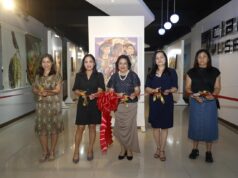Unwanting to reprint for the nth time my paean to the Aldo ning Capampangan that originally appeared in The Voice in 1998, I engaged in some quick top-of-mind randomness on everything Capampangan with the letters of the alphabet as only guide for some semblance of order.
Arayat, naturally comes first. The mountain that lords over the plains of Central Luzon impacts the majesty, if not the primacy, of the province over the rest of the region. Abe, dear friend, doubled to oneness in abe-abe, so central in the vocabulary as in our character as a distinct race, as we have long elevated ourselves to be. Augustinians, the harbingers of the Faith enshrined as much in the hearts and souls of the native Capampangans as in their magnifi cent churches.
Betis, arguably the church with the most Sistine Chapel-like ceiling in all the Philippines. Buru –fermented rice with fi sh or shrimps – pungent but ambrosiac, no true Capampangan can do without.
Clark. Once the bastion of American imperialism in the Asia-Pacifi c as host to the largest US military installation outside continental USA, now a bustling freeport with an airport long-promised to be the country’s premier international gateway.
Dugong aso. Long (mis)impressed as backbiting treachery, in actuality referencing to dogged devotion, okay, canine loyalty. Don Perico. Traitor to his landowning class, he fathered socialism in the Philippines, and – to me – equals in greatness the martyrdom of his brother, Chief Justice Jose Abad Santos.
Ebun, principal agro-product that formed one half of Candaba town’s iconic festival, cause of the province’s economic woes with the bird flu scare in August-October. Everybody’s Café, unarguably serving the best in home-cooked Capampangan dishes, major contributor to Pampanga being hailed the Culinary Capital of the Philippines.
Furniture and furnishings, from the antique to the “antiqued” that gave the world “Betis Baroque” to exotic rattan, metal and cast-iron, all crafted exquisitely by the country’s best artisans.
GMA. Love her. Hate her. But there’s no denying the economic fundamentals instituted during her watch did the nation good. And she still wins elections, even during her incarceration, er, hospital arrest, with or without her neck brace.
Hot air balloon. Once the only thing Clark was good at. Now, much better off in Lubao. Go, ask the balloonists themselves. H – in the Capampangan tongue – silent where present, stressed where absent. As in hay ev ha aws hin onolulu, awaii.
Ilustrado, the social class to which every Capampangan assumes himself/herself as belonging to, no matter his/her socio-economic condition. With outward manifestation in his/her being –
Japorms, showy but chic in style and fashion, ever dressed to the nines even when the pocket holds but a dime.
Kamaru, mole cricket, invariably cooked deep-fried adobo. Reputedly an aphrodisiac for the Capampangan macho.
Leguan – a living, walking celebration of beauty is the Capampangan woman, as the local ditty puts it aptly, aro catimyas na nitang dalaga…
Mequeni – a most welcoming invitation as much to the home as to the heart of the Capampangan.
Nanay. Motherhood becoming the best practice of provincial governance.
O’t. What other dialect, or language for that matter, possesses a word comprising two letters conjoined by an apostrophe? O’t macanyan ca? O’t balamu matudtud ya mu ing meangu bie.
Parul¸ the Christmas lantern that is both shibboleth of our faith as Catholics and our culture and craftsmanship as Capampangan taken to gigantic proportions with the City of San Fernando’s signature festival. Pinatubo, from which devastating eruption triumphed, excelled, soared the Capampangan spirit to greater heights of development and glory.
Qng, queca, queni, quibal, calaquian, tuquil… the Q in Capampangan words losing to the Tagalog’s K. What gives?
Religious, the first Filipino priest and nun were Capampangans. So was the first Filipino cardinal. Rebellious, the first major, major revolt against the Spaniards was by the Capampangan Francisco Maniago.
Sinukwan, the deity-king of the ancient Capampangans celebrated in December’s other festival in the capital city. Sisig, hailed as the best pork dish in the world.
Tarik Soliman, Wikipedia says was “the fi rst warrior-hero who died for our freedom.”
Universities, at least seven in Pampanga, plus scores of colleges and other higher institutions of learning, making the province a center of education in the whole region.
Virgen de los Remedios, the beloved patroness of Pampanga, whose image, with the Santo Cristo del Perdon, is taken from town to town in a crusade of penitence and charity.
Wetlands, particularly the Candaba Swamp, where the annual migration of birds from temperate countries has put the province in the world wildlife map.
X, not for the cinematic rating but for the expletives easily rolling out of the Capampangan mouth. As in bolang, buguk, tigtig, luse, murit, turak, sira buntuc just for crazy.
Yabang, the single characteristic that defines the Capampangan most, among other ethnicities, er, tribes, er, other Filipinos.
Zest for life. Joie de vivre best expressed in Oyni’ng bie!
Luid ya ing Capampangan!




